On Monday this week we released GenInsights Q3 2022, and early this afternoon we were delivering an Executive Briefing to one of our clients with respect to this report.
Uncanny coincidence that …
1) our Executive Briefing included a discussion about what the data shows in terms of the latest performance stats for the 47 coal units still operating in the NEM, and the stations that seem to be having more operational issues than others (some units performing quite well – though you won’t hear too much about that in the news).
2) and then ending that conversation I find my Inbox containing a number of different questions from different journalists about what’s been happening at the Callide site, and the implications of this.
One of my alerts had notified me of a trip at Callide B1 earlier this morning, but I’d not had time to look – but the questions prompted me to have a bit of a look this afternoon, and here’s a quick summary in what time I have available.
(A) Early media coverage (prior to this article)
Before I’ve posted this article, a quick scans find a couple of different pieces of reporting:
1) On the Australian Sarah Elks wrote the ‘Blackout threat as power station shuts down’ this morning, mentioning the dreaded ‘blackout’ word – though:
(a) concerns would really be more relevant if there was to be an early burst of hot weather in a few weeks that drove demand higher;
(b) and noting that the two of the outages (noted below) should be short-lived things.
2) In the AFR this afternoon Mark Ludlow has written ‘Callide power station stumble stokes summer blackout fears’ … again using the dreaded ‘blackout’ word, but using a bit more context about what the risk might be.
3) On the ABC, Jasmine Hines and Paul Culliver wrote ‘Callide Power Station in central Queensland completely offline’ about what happened to be the event that lasted under 4 hours.
4) On RenewEconomy Jim Regan wrote ‘“Structural failure” takes Callide coal plant offline 18 months after dramatic explosion’, which includes the context …
‘In comments to ABC News, CS Energy chief Andrew Bills said the final operating unit, B1 also tripped on Friday morning, because a safety protection system detected a vibration on a heat pump.
“That’s kind of what I would consider normal operating practice, it’s just bad timing in terms of the other things that have occurred at Callide,” Bills said.
“To be in that position is incredibly disappointing,” he added. “It’s not good enough and we’re doing what we can to get that back online.”’
… and also notes
‘CS Energy says it hopes to have C3 back up and running by November 21. C4 was due to be back in action in December, after multiple delays to its timeline for repair.’
… but you’ll note from the following that both dates are are not current.
(B) Each of the four units
Let’s start at the end and work backwards with the 4 units on the site, using various widgets in our ez2view software …
Callide C4
There’s been no change in status of this project, in terms of expected return to service (i.e. still at 7th April 2023) since 5th November 2021 … i.e. coincidentally a full year ago.
Callide C3
Two days ago (on Wednesday 2nd November) we wrote about ‘Callide C3 unit suffers cooling tower issues’, and noted that (at that time) the expected return to service date was 21st November 2022. Here’s the ‘MT PASA DUID Availability’ widget showing two changes:
1) A new expected return to service date as 3rd January 2023; and also
2) Return initially at only 300MW capacity, stepping up in 2 steps to 350MW and 420MW (the Registered Capacity of the unit) but never (in the forecast horizon) reaching back to Maximum Capacity of 466MW.
(a) I’m curious to understand why…
(b) … but also remember what’s noted before about how Registered Capacity is a better measure of capability for coal units than Maximum Capacity.
Callide B2
As shown in the ‘Bids & Offers’ widget, the unit tripped late Tuesday afternoon (1st November) following a period of testing (see in the rebid reasons and also the ‘Fixed Load’ bid band used):
Not shown here, but in the image below, we see the unit is currently scheduled to be back online next Thursday (10th November 2022).
Callide B1
Rounding out the four units, B1 tripped this morning in the 07:30 dispatch interval as shown here in the snapshot of the ‘Unit Dashboard’ widget looking backwards 2 days:
As noted, the unit was back online by 11:00, so only a temporary glitch and (as far as I can see in the data that’s published by AEMO at this point) nothing to be overly concerned about … some readers might like to recall what Hugh Saddler wrote when he said ‘Power station (i.e. unit) trips are normal…’.
Finally today, here’s an update to the ‘Generator Outages’ widget showing the return to service dates of the 3 offline Callide units:
(C) Implications?
There’s some questions being asked about what this all means, but I’ve run out of time today and will have to address this later…


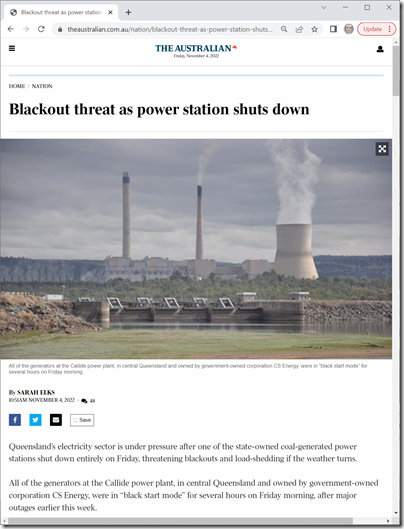
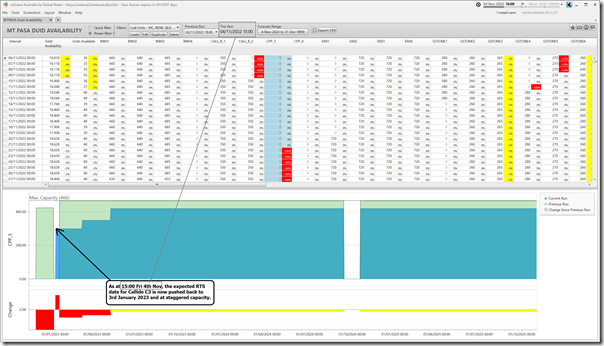
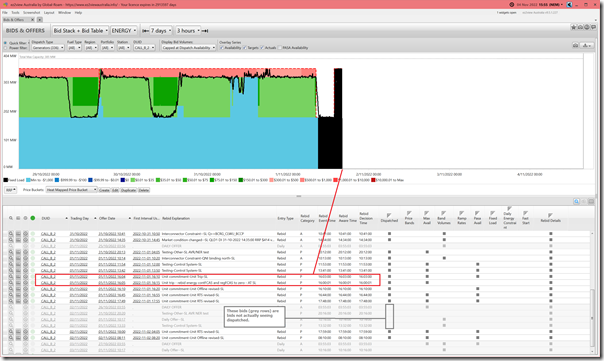
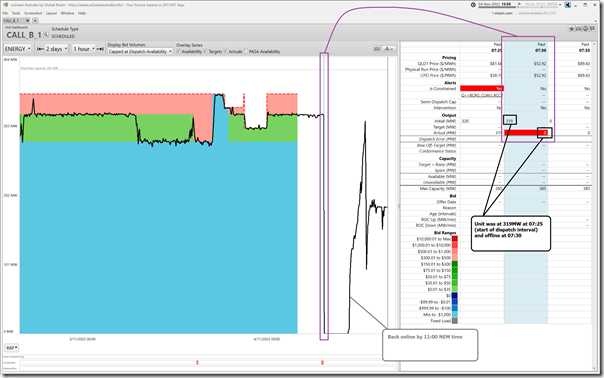
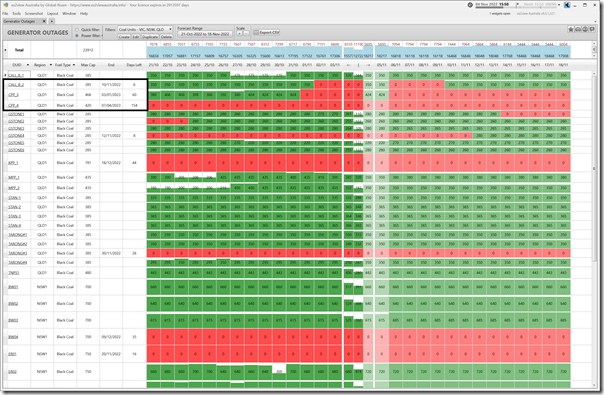
So CS Energy’s process safety management systems were not where they needed to be and the critical 220 VDC supply to unit C4 was turned off by maintenance staff without the operators that where in charge of the power plant operation knowing. So the insurance payout is lost and the cost is many $100M! It’s time that management was transferred to Snowy Hydro as they are the only public authority with the ability of managing power plant without wrecking it by ignorance(ignorance is only the lack of knowledge).